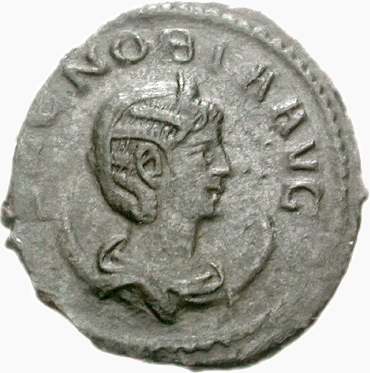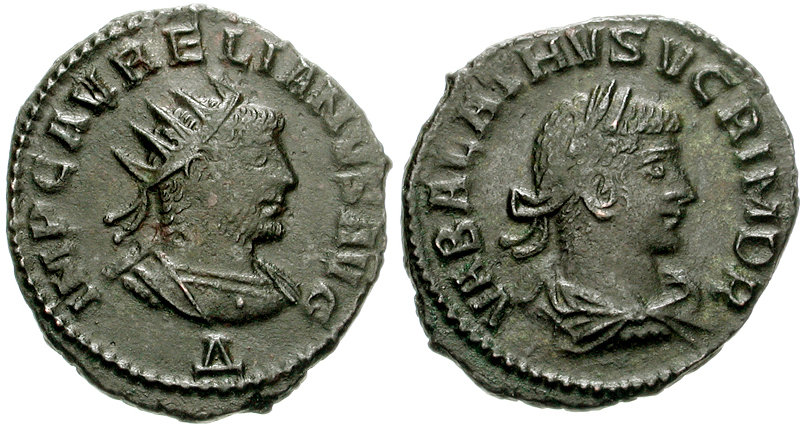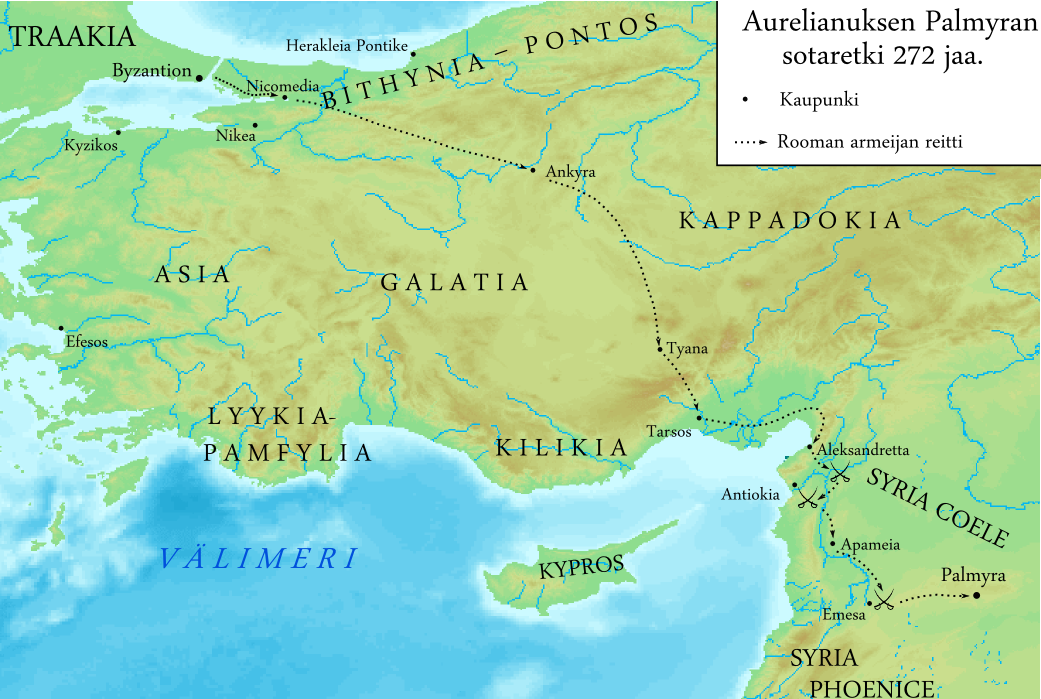|
Zabdas
Zabdas was a 3rd-century Syrian general who led the forces of Queen Zenobia of Palmyra during her rule as regent of her son Vaballathus and her subsequent rebellion against the Roman Emperor under the short-lived independent Palmyrene Empire. He led Palmyra's expeditions in the middle east which included annexing territory spanning from Roman Egypt to Asia Minor. Following Emperor Aurelian's campaign in the east and the fall of Palmyra, Zabdas, among other notable Palmyrene officials including Cassius Longinus was executed in Emesa after being held on trial by the emperor. Campaigns Expedition against the Tanukhids Aided by another general of the army, Septimius Zabbai, and Zenobia herself, Zabdas started an expedition against the Tanukhids in the spring of 270, during the reign of emperor Claudius II. Reasons cited for Palmyra's military campaign in Arabia are the weakness of Roman central authority over its eastern provinces and its corresponding inability to protect them, w ... [...More Info...] [...Related Items...] OR: [Wikipedia] [Google] [Baidu] |
Zenobia
Septimia Zenobia (Palmyrene Aramaic: , , vocalized as ; AD 240 – c. 274) was a third-century queen of the Palmyrene Empire in Syria. Many legends surround her ancestry; she was probably not a commoner and she married the ruler of the city, Odaenathus. Her husband became king in 260, elevating Palmyra to supreme power in the Near East by defeating the Sassanians and stabilizing the Roman East. After Odaenathus' assassination, Zenobia became the regent of her son Vaballathus and held de facto power throughout his reign. In 270, Zenobia launched an invasion that brought most of the Roman East under her sway and culminated with the annexation of Egypt. By mid-271 her realm extended from Ancyra, central Anatolia, to southern Egypt, although she remained nominally subordinate to Rome. However, in reaction to the campaign of the Roman emperor Aurelian in 272, Zenobia declared her son emperor and assumed the title of empress (declaring Palmyra's secession from Rome). The Romans were ... [...More Info...] [...Related Items...] OR: [Wikipedia] [Google] [Baidu] |
Tenagino Probus
Tenagino Probus was a Roman soldier and procuratorial official whose career reached its peak at the end of the sixth decade of the third century AD (c. 255–260). A poverty of primary sources means that nothing is known for certain of his origins or early career. However, in later years he served successively as ''Praeses'' (governor) of the province of ''Numidia'' (i.e. ) and of Egypt, (i.e. ''Praefectus'' ). These were both very senior procuratorial offices, the latter in particular traditionally considered one of the pinnacles of an equestrian career. In these roles he exercised military skills in addition to administrative ones; as he led military operations outside his province. He died resisting the invasion of Egypt by the forces of Zenobia of ''Palmyra'' in the troubled between Emperors Claudius II and Aurelian. Despite the limited availability of information about Probus, the fact that he was: (i) entrusted with the government of two of the Empire's most economicall ... [...More Info...] [...Related Items...] OR: [Wikipedia] [Google] [Baidu] |
Battle Of Immae
The Battle of Immae was fought in 272 between the Roman army of Emperor Aurelian, and the armies of the Palmyrene Empire, whose leader, Queen Zenobia, had usurped Roman control over the eastern provinces. Background and prelude to war During the Crisis of the Third Century, Rome had lost its ability to defend its eastern provinces from Sassanid invasion. Septimius Odaenathus, a chieftain out of Palmyra, improvised an army that proved highly successful in repelling the Sassanid onslaught. He was so successful that Gallienus made him a king and protector of the eastern empire. After his death his wife Queen Zenobia assumed direct control (through her son) of the eastern Roman Empire provinces that were under Palmyrian protection. Through shrewd diplomacy she managed to expand her holdings into Egypt and convinced much of Asia Minor to call Palmyra its capital, effectively carving out a Palmyrene Empire. Publicly she maintained the facade of a partnership with Rome by at all times ... [...More Info...] [...Related Items...] OR: [Wikipedia] [Google] [Baidu] |
Palmyrene Invasion Of Egypt
The Palmyrene invasion of Egypt occurred in the summer, or possibly in October, of 270 AD when the forces of Queen Zenobia of Palmyra, led by her general Zabdas and aided by an Egyptian general named Timagenes, invaded and subsequently annexed Egypt, which was under control of the Roman Empire at the time. The invasion of Egypt is sometimes explained by Zenobia's desire to secure an alternative trade route to the Euphrates, which was cut because of the war with the Sasanian Empire, although the Euphrates route was only partially disrupted. Zenobia's personal ambition and political motivation to establish Palmyrene dominance over the east definitely played a part in her decision to invade Egypt. The invasion coincided with, or probably even caused, serious unrest in Egypt, whose people were split between supporting and defying the approaching Palmyrene army. What also made the situation worse for the Romans was that the prefect of Egypt, Tenagino Probus, was at the time preoccup ... [...More Info...] [...Related Items...] OR: [Wikipedia] [Google] [Baidu] |
Sack Of Bostra
The Sack of Bostra occurred around the spring of 270 AD when Queen Zenobia of Palmyra sent her general, Zabdas, to Bostra, the capital of Arabia Petraea, to subjugate the Tanukhids who were challenging Palmyrene authority. The sack marked the beginning of Zenobia's military operations to consolidate Palmyrene authority over the Roman east. During the sack, the governor of Arabia Petraea at the time, a certain Trassus, attempted to confront the Palmyrenes but was defeated and killed, while the city was sacked and the Legio III Cyrenaica's revered shrine, the temple of Zeus Hammon, was destroyed. The sack of the city was shortly followed by the subjugation of Arabia and Judea, and later a full invasion of Egypt, and is the first in the string of events which ended in open rebellion against the Roman Empire and the declaration of an independent Palmyrene Empire. Background In 269, while the Romans were occupied with defending the empire against Germanic invasions, Zenobia was c ... [...More Info...] [...Related Items...] OR: [Wikipedia] [Google] [Baidu] |
Battle Of Emesa
The Battle of Emesa was fought in 272 between the Roman armies led by their emperor Aurelian and the Palmyrene forces led by their queen, Zenobia and general Zabdas. Background Aurelian had started a campaign to reconquer the secessionist Palmyrene Empire, led by Queen Zenobia, regent of her son, King Vaballathus. The Palmyrene Empire had already conquered most of the former provinces of the Roman east, including territory spanning from Ancyra to Alexandria. In 272, Aurelian crossed the Bosphorus and advanced quickly through Anatolia. Marcus Aurelius Probus regained Egypt from Palmyra, while the emperor continued his march and reached Tyana. The fall of Tyana lent itself to a legend; Aurelian to that point had destroyed every city that resisted him, but he spared Tyana after having a vision of the great philosopher Apollonius of Tyana, whom he respected greatly, in a dream. Whatever the reason for his clemency, Aurelian sparing Tyana paid off, many more cities submitted to h ... [...More Info...] [...Related Items...] OR: [Wikipedia] [Google] [Baidu] |
Palmyrene Empire
The Palmyrene Empire was a short-lived breakaway state from the Roman Empire resulting from the Crisis of the Third Century. Named after its capital city, Palmyra, it encompassed the Roman provinces of Syria Palaestina, Arabia Petraea, and Egypt, as well as large parts of Asia Minor. The Palmyrene Empire was ruled by Queen Zenobia, officially as regent for her son Vaballathus, who inherited the throne in 267 at age ten. In 270, Zenobia rapidly conquered most of the Roman east, attempting to maintain relations with Rome as a legitimate power. In 271, she claimed the imperial title for both herself and her son, fighting a short war with the Roman emperor Aurelian, who conquered Palmyra and captured Zenobia. A year later the Palmyrenes rebelled, which led Aurelian to destroy Palmyra. Despite its brief existence, the Palmyrene Empire is remembered for having been ruled by one of the most ambitious and powerful women in antiquity. It is also hailed in Syria, where it plays an import ... [...More Info...] [...Related Items...] OR: [Wikipedia] [Google] [Baidu] |
Vaballathus
Septimius Vaballathus (Palmyrene Aramaic: , , vocalized as ; ar, وهب اللات, translit=Wahb Allāt; 259 – c. 274 AD) was emperor of the Palmyrene Empire centred at Palmyra in the region of Syria. He came to power as a child under his regent mother Zenobia, who led a revolt against the Roman Empire and formed the independent Palmyrene Empire. Early life Lucius Julius Aurelius Septimius Vaballathus was born and raised in the city of Palmyra, an oasis settlement in the Syrian Desert in 259 to the king of kings of Palmyra, Odaenathus, and his second wife, queen consort of Palmyra, Zenobia. Vaballathus is the Latinized form of his Palmyrene name, ''Wahballāt'', "Gift of Allāt". As the Arabian goddess Allāt came to be identified with Athena, he used ''Athenodorus'' as the Greek form of his name. He had a half-brother, Hairan I, born from his father and another woman, who reigned as co-king of kings with his father, and a lesser-known brother, Hairan II. He also might have ... [...More Info...] [...Related Items...] OR: [Wikipedia] [Google] [Baidu] |
Septimius Zabbai
Zabbai was a Palmyrene man who lived in the third century, and likely was a member of the Palmyrene nobility. Nothing is known about him other than the reference in Queen Zenobia's Palmyrene name recorded in Palmyrene inscriptions, sptymy'btzby, which translates as Septimia Daughter of Zabbai. Zenobia's Palmyrene name might hint at her family origins, and might tie with the medieval tradition recorded by medieval Persian scholar Al-Tabari that she was the daughter of an Arab sheikh. However, it is also possible that Zenobia may not have been Zabbai's daughter, with the inscription implying that she belonged to a family whose ancestral head was Zabbai. Another man named Zabbai from this time in Palmyrene history is one of Zenobia's generals, who along with Zabdas Zabdas was a 3rd-century Syrian general who led the forces of Queen Zenobia of Palmyra during her rule as regent of her son Vaballathus and her subsequent rebellion against the Roman Emperor under the short-lived indepe ... [...More Info...] [...Related Items...] OR: [Wikipedia] [Google] [Baidu] |
Palmyra
Palmyra (; Palmyrene: () ''Tadmor''; ar, تَدْمُر ''Tadmur'') is an ancient city in present-day Homs Governorate, Syria. Archaeological finds date back to the Neolithic period, and documents first mention the city in the early second millennium BC. Palmyra changed hands on a number of occasions between different empires before becoming a subject of the Roman Empire in the first century AD. The city grew wealthy from trade caravans; the Palmyrenes became renowned as merchants who established colonies along the Silk Road and operated throughout the Roman Empire. Palmyra's wealth enabled the construction of monumental projects, such as the Great Colonnade, the Temple of Bel, and the distinctive tower tombs. Ethnically, the Palmyrenes combined elements of Amorites, Arameans, and Arabs. The city's social structure was tribal, and its inhabitants spoke Palmyrene Aramaic, a variety of Western Middle Aramaic, while using Koine Greek for commercial and diplomatic purposes. ... [...More Info...] [...Related Items...] OR: [Wikipedia] [Google] [Baidu] |
Claudius II
Marcus Aurelius Claudius "Gothicus" (10 May 214 – January/April 270), also known as Claudius II, was Roman emperor from 268 to 270. During his reign he fought successfully against the Alemanni and decisively defeated the Goths at the Battle of Naissus. He died after succumbing to a "pestilence", possibly the Plague of Cyprian that had ravaged the provinces of the Empire. Early life and origin The most significant source for Claudius II is the collection of imperial biographies called the ''Historia Augusta''. However, his story, like the rest of the ''Historia Augusta'', is riddled with fabrications and obsequious praises. In 4th century, Claudius was declared a relative of Constantine the Great's father, Constantius Chlorus, and, consequently, of the ruling dynasty. The ''Historia Augusta'' should be used with extreme caution and supplemented with information from other sources: the works of Aurelius Victor, Pseudo-Aurelius Victor, Eutropius, Orosius, Joannes Zonaras, an ... [...More Info...] [...Related Items...] OR: [Wikipedia] [Google] [Baidu] |
Palmyrene Army
Palmyra (; Palmyrene: () ''Tadmor''; ar, تَدْمُر ''Tadmur'') is an ancient city in present-day Homs Governorate, Syria. Archaeological finds date back to the Neolithic period, and documents first mention the city in the early second millennium BC. Palmyra changed hands on a number of occasions between different empires before becoming a subject of the Roman Empire in the first century AD. The city grew wealthy from trade caravans; the Palmyrenes became renowned as merchants who established colonies along the Silk Road and operated throughout the Roman Empire. Palmyra's wealth enabled the construction of monumental projects, such as the Great Colonnade, the Temple of Bel, and the distinctive tower tombs. Ethnically, the Palmyrenes combined elements of Amorites, Arameans, and Arabs. The city's social structure was tribal, and its inhabitants spoke Palmyrene Aramaic, a variety of Western Middle Aramaic, while using Koine Greek for commercial and diplomatic purposes. ... [...More Info...] [...Related Items...] OR: [Wikipedia] [Google] [Baidu] |






